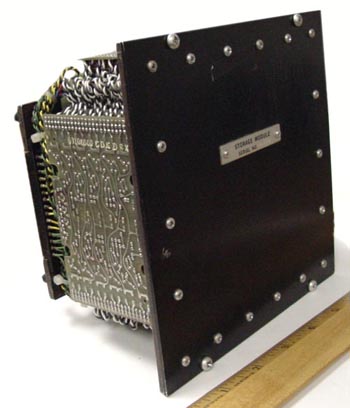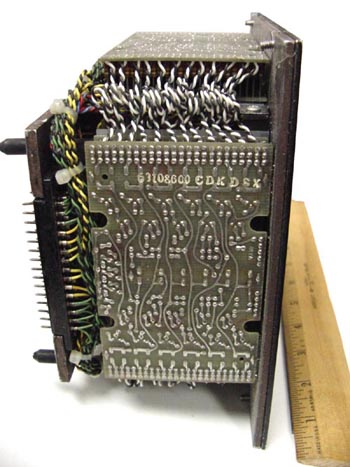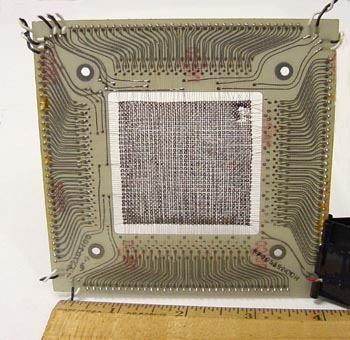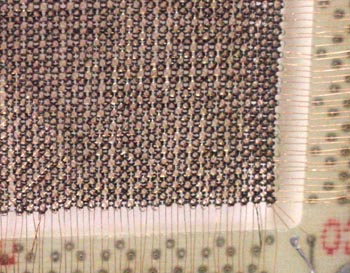Early Memory Technology
| This is one "Storage Module" as used in the CDC 6000 series machines.
Overall dimensios are 7" x 7" x 4" (approx 18 x 18 x 10 cm) with the face and rear plates made of 1/4 inch steel.
The other four outer surfaces are comprised of cord-wood circuit modules, and this all encloses 12 "planes" of core memory as shown below. |

|
| This is a side view of the module which shows clearly how the cord-wood circuit modules
enclose the core planes hidden inside.
The cord-wood modules are connected by sets of "twisted pair" leads (black-and-white wires) to each of the planes. The module as a whole is connected into the computer by two sets of two rows of pins on the rear surface. |

|
| This is a single plane of core memory. It it is a matrix of 64 by
64 (= 4096) ferrite cores, each threaded
by (Note - it looks from the picture as if you are seeing the classical "doughnut" shaped cores - but if you count the doughnuts, you will see that it appears to be only a 32 by 32 matrix. In fact what appear to be a doughnuts in the picture are actually pairs of two "cores", each of which is roughly semi-circular in shape. There are 32 traces (wires) visible along each edge of the matrix, but there are two sides to the plane, making 64 wires per edge.) Each core could hold one bit, thus the 12 planes constituting one storage module held 4K of 12-bit words. And weighed approximately 6 lbs. (approx 2.5 Kg) Each of the four corners has two black-and-white twisted-pairs that connect to the surrounding cord-wood modules. |

|
| A closer view of the ferrite cores (apparent "doughnuts") and the wires that thread them together.
For a more magnified view of this core plane and the wiring through the doughnuts, go to Enlarged View | 
|
|
Arranged in stacks of 12 planes, each module
provided 4K (4096) of 12-bit words. Thus five modules in a column gave 4K of 60-bit
words where the stacks are interleaved - accessing each 12 bits
concurrently - with, incidentally, one bit per plane ALSO being sampled per
clock cycle - AMAZING technology! Four columns gave 16K 60 bit words. These
were arranged in a door in the mainframe, thus each door had 20 modules in a module-plane.
Four doors per memory chassis, one module-plane a door, gave four 5 x 4 module-planes totaling 64K or 65,536 12 bit words. Two memory chassis, two of the limbs on the cross of the mainframe, give you a 128K machine, or 131,072 60 bit words - Hence the 131 K size of these machines... The other two limbs of the mainframe cross were the Central Processor and the Peripheral Processor chassis. Each PPU had a single memory module, totalling five on top and five on the bottom, each sharing a "slot" in the barrel-type PP logic proper. |
|